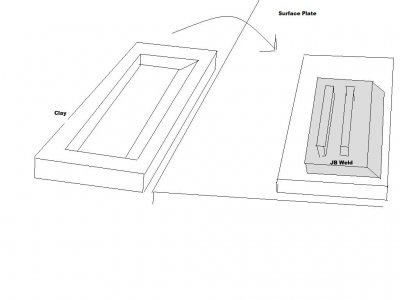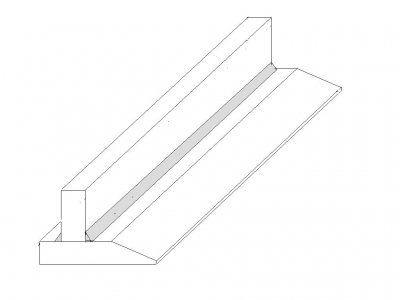I was mulling over straight edges and just can't see spending too much on one to scrape in my hobby level machine tools. I have a small prism I made form some windows weights, and it turned out great and the price was perfect, LOL. (Free). It's about 1.25 x 11.
I will need a couple of larger ones for the G0704 though, so I set about pondering cheap alternatives.
(1) What about casting JB weld against the surface plate? Using a clay "mold" you could cast right on the plate (After several coats of wax) and it should be a mirror of the extremely flat reference. You could insert some "ribs" while it cures to give it some additional stability... granite perhaps? The cool thing about this one is you could still "scrape it in" using traditional methods.
2) Combining granite tile cuts to create a straight edge and joining them with epoxy..... you can test the flatness of it before continuing and if you assemble it on the surface plate it should maintain it's flatness pretty well I'd think. There would have to be some vetting of the tiles as you went to make sure the cuts didn't throw it out of wack.
In the end, as long as it's stable(ish) and flat.... does it matter how/what it's made of? (Well... at least in a hobby setting.)
It's certainly inexpensive to try it out..... maybe $40 for both to give it a whirl.
Am I completely nuts? I don't see any drawbacks IF it works as expected... one key fact I'm off to research is if I can find any thermal expansion rates for JB Weld (Or any other epoxies.... I keep mentioning them but I swear I'm not a shill, LOL!)
CoC Pics attached


I will need a couple of larger ones for the G0704 though, so I set about pondering cheap alternatives.
(1) What about casting JB weld against the surface plate? Using a clay "mold" you could cast right on the plate (After several coats of wax) and it should be a mirror of the extremely flat reference. You could insert some "ribs" while it cures to give it some additional stability... granite perhaps? The cool thing about this one is you could still "scrape it in" using traditional methods.
2) Combining granite tile cuts to create a straight edge and joining them with epoxy..... you can test the flatness of it before continuing and if you assemble it on the surface plate it should maintain it's flatness pretty well I'd think. There would have to be some vetting of the tiles as you went to make sure the cuts didn't throw it out of wack.
In the end, as long as it's stable(ish) and flat.... does it matter how/what it's made of? (Well... at least in a hobby setting.)
It's certainly inexpensive to try it out..... maybe $40 for both to give it a whirl.
Am I completely nuts? I don't see any drawbacks IF it works as expected... one key fact I'm off to research is if I can find any thermal expansion rates for JB Weld (Or any other epoxies.... I keep mentioning them but I swear I'm not a shill, LOL!)
CoC Pics attached


